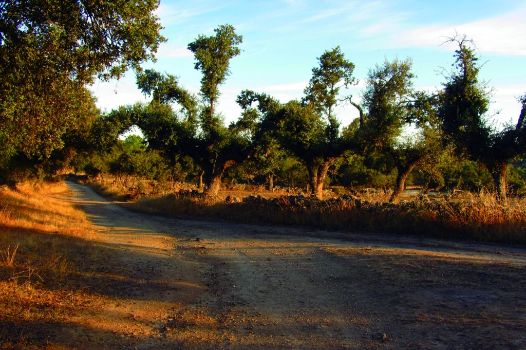Net of Natural
Trails

Stage 27: Cozcurrita - Fariza
Description
In the heart of County Sayago
This is one of the shortest Sections of the Duero Nature Trail. It links the towns of Cozcurrita and Fariza, in the heart of County Sayago, where the diverse landscape constantly surprises the visitor, in particular, the towering rocky outcrops with whimsical shapes.
The route begins near the recently restored Romanesque church of Santa María Magdalena. The path begins to descend almost immediately, with views of the opposite slopes where the dominant species is the holm oak (Quercus ilex).

In the beginning, the road is narrow and the landscape is dominated by a rich variety of species typical of the Mediterranean forest.
After about 200 metres, the trail crosses a stone pontoon on Valdecrejas Creek. On the opposite side, a path leads to Matarrana grain mill. From here, the path continues up with a stone wall always on the right, and holm oaks and prickly junipers (Juniperus oxycedrus) on the left. The granite outcrops that abound in this area also intrude onto the path.
At a place known as El Modorro, the route runs along a wide, well-kept path surrounded by holm oaks, junipers and thyme (Thymus sp.) until it reaches the Km 1 milestone of this Stage.
From here, the landscape changes to natural hay meadows surrounded by stone walls along which the route continues. In summer, one can see the harvesting and baling of hay in rolls that are fed to livestock when kept in stables.
The Trail is dotted with holm oaks interspersed with olive trees: an example of effective use of natural resources, always directly linked to cattle farming.
The Nature Trail crosses the Puente Grande on Eras Creek, and reaches the centre of Fariza, the county capital, where this short Stage ends.
Enlaces de interés
Profile

Highlights
Further information
Mediterranean forest
The plant species that make up the Mediterranean forest have small, hard and evergreen leaves. The leaves have adapted to reduce water loss during the summer droughts typical of the Mediterranean climate.
The most representative species is the holm oak. The leaves are hard, spiny and covered with a protective wax to save water during the summer. Almost all parts of the oak have been used throughout history. Its wood has been used as fuel and as timber or to make charcoal; its fruit, the acorn, is used as livestock feed, and the tannins (alcoholic compounds that protect the wood from insects) are used for tanning hides.



